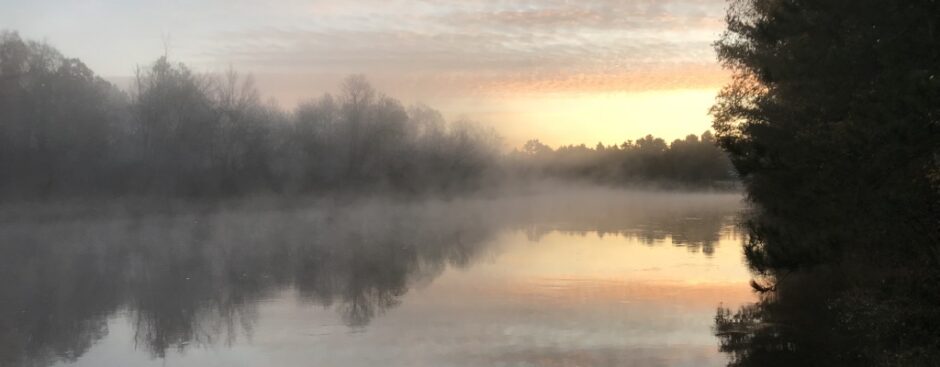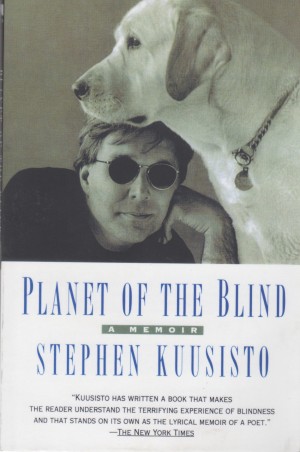Planet of the Blind by Stephen Kuusisto (1998. Delta. ISBN 978-0-365-3327-6)
I met poet and memoirist Stephen Kuusisto over a glass of hard cider in Helsinki when we were both looking for Finnish poet, Jarkko Laine. Not really. Though, in some sense, bits and pieces of that sentence are allusions to truth. I’ve never really met the author of this fine memoir. We’ve only exchanged an email or two regarding our mutual acquaintance, former President of the Finnish Writers’ Union and Turku poet Jarkko Laine. But I was so intrigued by Stephen’s short homage to Jarkko (go to http://www.planet-of-the-blind.com/poetry/ to read the essay), well, I had to read more. Not being much a poetry guy (sorry, Jarkko and Stephen), I ordered Planet of the Blind, Kuusisto’s first memoir. I expected, from the accolades surrounding the book on Amazon, that I would enjoy the slim volume over a crisp autumnal weekend. To be honest, that’s not how it went: I devoured the book in a day. Eight hours of straight, non-stop reading happened. Many times, cover blurbs are a “bait and switch” proposition: The author knows someone who knows someone who tells a little white lie about a book to help out the author. I’ve been burned by blurbs. I’m sure you have too. So when no less than that seminal arbiter of American culture, The New York Times, says that the book “stands on its own as the lyrical memoir of a poet”, well, I was a bit skeptical. Not to worry. That phrase is spot on in describing this great little work of non-fiction.
Using the term “lyrical” to describe prose writing can be a bit of an overstatement. But here, The Times got it right. The vignette style of Kuusisto’s storytelling sets exactly the right mood and pace for telling the life story of a blind poet. Think of that nomenclature, if you will. A blind poet. Some might quibble and point out, “Oh, Kuusisto isn’t really blind blind. He has some sort of residual seeing ability in both eyes.” Really? What circumstances define blindness if being unable to read a book or a street sign; or walk without stumbling over a crack in the sidewalk; or discern a bus from an elephant; or ride a bicycle; or watch television; or visit an art gallery and actually see the paintings; doesn’t “pass the test”? Kuusisto’s Finnish sisu is omnipresent in this story as he tries repeatedly to model such a twisted perception: as he tries very, very hard not to be blind despite his inability to see. The results are painful. And funny. And touching, as in this childhood scene:
At night I sit in the heavy vigil of personal confinement. I eat alone in my room. In my obscure corner I brood over my ugliness. I am a green and distorted mass. My eyes dart about in my head. Who wouldn’t laugh? This is my face, blubbering, cross-eyed.
Here come the villagers with their blazing torches, pursuing the Frankenstein monster to the ruined castle.
Kuusisto grew up in an era when there were few, if any, services for the disabled in public schools. His reportage of his struggles reminds me, for the first time in decades, of kids I went to school with. The physically and the mentally challenged were dumped by all the western junior high schools (there were four back then) in my hometown into two classes. Those kids, whether they were Down Syndrome of low intellect, or brilliant but blind (as one kid, a concert-level pianist at age 13 was) shared two teachers and didn’t move from classroom to classroom by subject, like the rest of us. Their entire lives were dictated by the four walls of their “special classes”. There was no interaction, no integration, with the rest of us except during lunch, when the “dummies” sat at their own table and we all stared at them as if they were freaks on holiday from a sideshow. That’s what Kuusisto lived, to some extent. That’s the heart of his story.
Still walking around, feigning sight, I step in the rain-washed gutter, brush the street sign, and make a hundred slapstick gestures…A friend calls saying she’ll meet me downstairs in half an hour. She drives a red Chrysler. I walk down the street and approach the car. I reach for the door…but it’s locked. I rap…Then I walk around to her side of the car…When I lean down to her window, I see at last the face of a genuinely terrified Chinese woman.
Exemplary writing by contemporary authors is uncommon. Despite all the books; self-published, mainstream, and digital that exist today in the American marketplace of ideas; very few of the volumes clogging our shelves or sitting in our eReader queues can be labeled works of excellence. This memoir is one of them. Rarely does a heartfelt scene reduce this trial judge to tears. But I found myself weeping as I witnessed Stephen’s transition from blindness to functionality when he took the leash of his first Seeing Eye companion, Corky.
“Go on now. Corky isn’t going to let anything happen to you…”
I tell her that I believe that Corky will prevent me from walking off the (train) platform, that I believe Corky is as good as her noble reputation…
Inwardly I am thinking, “What if the dog belongs to a suicide cult?”
Then I laugh and I exhort Corky to go forward. She yanks me backward, turns, walks me in the opposite direction until we are safely away from the tracks. Faith moves from belief into conviction, then to certainty.
The New York Times pegged this book. It is, to overuse the phrase, lyrical in the manner of fine, classic poetry.
5 stars out of 5. The perfect book to read with a roaring fire and a cup of hot cocoa.




Twitter: ConnieKuusisto
says:
Wow. I can’t wait to share your very kind words with Steve. He’ll be so pleased…
My pleasure. It brought back, as my review indicated, my own small memories of dealing with the disabled in junior high school. Steve should know that my pal, Gerry Henkel (1/2 Finn and the editor of New World Finn newspaper) asked for permission to use the review. It will be in the next issue. NWF is a great little gem of Finnish-American culture and, as a non-Finn writing about Finns, I enjoy it immensely.
Mark
Twitter: ConnieKuusisto
says:
By the way, Planet of the Blind will soon be released as an eBook. Needless to say, we’re a little excited!